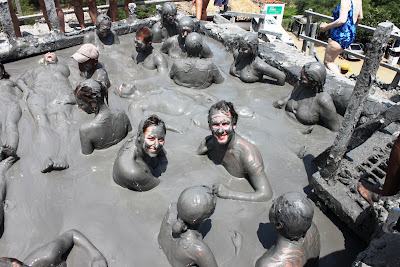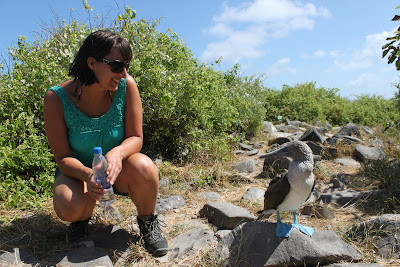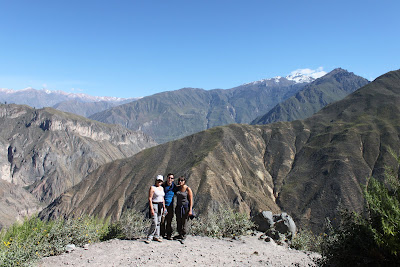I’m sure that getting on that plane will be a mixture of emotions. A sense of achievement that we have travelled a large part of South America, overcome various obstacles and done things we wouldn't ordinarily have done. But also sadness that the trip has finished with a little anticipation as to what's ahead.
South America is about nature. Most of the truly memorable experiences have involved marvelling at its natural wonders: the strange and exotic (the Blue-Footed Booby), the colossal size (Iguazu Falls) or the vast expanse of wilderness (Patagonia). We’ve seen extremes of all kinds: deserts, jungles, glaciers, swamps and steppes.
In fact the experiences that have been the most disappointing or uncomfortable have usually been those man-made: smelly buses, rude tourists or rip-off merchants.
Four months ago we knew very little about South America: "La Paz?"; "Pisco sour?"; "Going full circle around the continent should be do-able in four months". We arrived with only the first three nights booked and no plans with more than four months ahead of us – an exciting but daunting prospect.
Since we sketched out our first rough route on a paper napkin in a Buenos Aires café, we have constantly been on the move and rarely stayed in one place for longer than four days. We’ve spent days organising activities or going with the flow; on long bus rides or relaxing with a beer and a book. Some have been unforgettable (for good or bad), some amazing, thought-provoking, educational or just weird; others disappointing or exhausting. However, whatever kind of day it’s always been an experience.
It’s easy to see what we’ve learnt about South America: its geography, people, culture and a bit of its language. But in terms of life lessons it’s been – put the guidebook down!
The best hostels were those not in the Lonely Planet; some of the best experiences were the ones that barely had a mention. Places rated highly were sometimes disappointing. The guidebook was used less and less as we relied more and more on recommendations or following what we wanted to do, rather what we felt we should do. The satisfaction of “discovering” something and making an experience your own is what travelling is all about.
It’s also been a great time to reflect, refresh and catch up on some great American TV series we never had time to watch before.
So what have been our best / worst bits? In the spirit of an end-of-year countdown here are our ups and downs of South America. For the sake of balance, let’s get the worst bits out of the way first.
- Stomach bugs: One bout is annoying and unpleasant but expected when you are in a foreign country eating strange food. Three, however, is grossly unfair and really makes you crave crappy daytime UK television, a fully functioning toilet and a fully stocked supermarket (See majority of Bolivian blog entries)
- Budget: If there has been one continuing bugbear it has been watching the magical disappearance of notes from the wallet, or the shock following a telephone call to the credit card company. Even the most liberal and care-free traveller would find it difficult to enjoy Machu Picchu having just got off the phone with John from Nationwide. It's astounding how much money you spend without realising and how difficult it is to budget (See El Calafate, Argentina)
- Bolivian buses: There´s little you can do when sitting on a bus full of shit. They say laughter is the best medicine. This works for the first five minutes but after that its best to go to a happier place and stay there until you´re off the bus (See Bolivian Bus entry)
- Indecision: There´s nothing worse than not doing anything because you’re working out what you think you might do next. There’s a whole new world outside your window and you’re sitting in your room glued to a laptop working out whether to stay or go and what you might miss if you did either (See Buenos Aires and parts of Peru)
- Tour groups: They´re not all bad, but being herded on and off a bus to see various ‘important sites’ surrounded by slightly sour-faced tourists (you're on holiday right?) does take the appeal out of the experience (See bus Puno to Cusco)
- Plantains: What´s the point? They´re just a crap banana. This also extends to food where all flavour has had the life fried out of it. South America is packed full of exotic fruits – use them! (See Ilha do Mel, Brazil and parts of Colombia)
- Party hostels: Fun if you’re the one talking crap until the early hours with someone you don’t know. Not so fun if you’re the person getting up at dawn the next morning and you’re trying to sleep.
And now...the top ten of South America according to Mark and Gemma:
1. Galapagos islands, Ecuador
An obvious first choice.
Nothing compares to it – the islands are beautiful, the sea is crystal clear, and of course there is the unique wildlife. There was also the luxury boat, a guide who genuinely seemed to love what he was doing, a nice group of people and a feeling that every minute was a once-in-a-lifetime moment.

2. Iguazu falls, Argentina & Brazil
Beforehand, it was difficult to imagine that the falls would offer a personal experience considering the numbers of people that flock there. Surprisingly, this was not the case.
The falls are awe-inspiringly colossal – in your face Niagara Falls! Despite the size, the roar of the cascading water, the tourists and the searing humid heat, there’s a tranquillity to be found. People say that the falls give off a positive energy and I can believe that. It’s a mixture of exhilaration and peace.
Also, both the Brazilian and Argentine sides are as good as each other - what are the chances? Hey North America, put that in your pipe and smoke it!

3. Machu Picchu and The Sacred Valley, Peru
It´s an obvious one and features on all top 10 lists of South America (usually at number 1). Not only is Machu Picchu a pre-Columbian settlement untouched by invading conquistadors and with its own intrinsic beauty but it’s set against a backdrop of breath-taking lush green mountains. It´s impossible to take a bad photo there.
But whilst Machu Picchu whores itself to the masses, Pisac has an understated charm. There were no crowds, stunning mountain scenery and beautiful ruins hugging the cliffs. Along with the clear blue skies and a nice little colonial town, Pisac is on a par with Machu Picchu. You can´t underestimate the power of having a place like this to yourself.

4. San Pedro de Atacama, Chile
A place has to be special if even a noisey, over-priced and generally crappy hostel can´t spoil the atmosphere. Poised on the edge of Bolivia and he beginnings of Andean culture, it´s difficult not to be taken in with the extremes here – the dry desert, the altitude and the heat as well as the sites: salt lakes, geysers, cactus canyons, dunes and deserted hot springs. The town wasn’t so bad either!
5. Pucon, Chile
Waking up in the dead of night to do physical activity is difficult to get excited about. Climbing Volcan Villarica exceeded any expectations. It wasn't a stroll or a nice amble up a mountain. It was ice axes and crampons, extreme weather clothing and a four-hour ascent. There´s a lot of our sweat and tears on that there volcano.
There was also zipping high up through the dense rainforest canopy on a wire, hot natural spas and a wooden town that has kept its charm despite the tourist influx.

6. Colca Canyon, Peru
Seeing a bird the size of a cow swooping up from one of the deepest canyons in the world is pretty special.
As is descending a trench plonked in the wilderness, a few hundred kilometres passed the last patch of wilderness in the knowledge that there's a mule waiting for you at the bottom. Standing on the edge of the canyon is like being on another planet: one like earth, but just a lot bigger. Like most natural wonders it makes you feel very small indeed.

7. 4x4 trip, Bolivia
This is all the landscape we´ve experienced before, but amplified. Up to this point we'd seenplenty of wilderness (27 hours of Patagonia on a bus to Bariloche) but nothing as ethereal and un-earthy as the high altitude border from Chile into Bolivia, the blinding white of the Uyuni salt flats, the weird shaped rocks and the strange-coloured lakes (blue, green...and red?).
8. Torres del Paine, Chile
This entry is about triumph over adversity. We´re not outdoor types, in fact we looked pretty out of place compared to the serious trekkers there. But four nights camping, cooking your food and carrying everything with you is an achievement by any standards (and one that surely deserves a Duke of Edinburgh 24-carat gold badge?). Of course the landscape took our breath away as did the sheer slopes we climbed and the rucksacks we carried. We also felt like a million dollars for weeks afterwards.
9. Nazca lines, Peru
Flying in a one-engine plane to view strange, ancient images etched into the dry and barren desert below is not an experience you have very often. It doesn´t take long to get over a fear of flying as you buzz over the Nazca lines and witness the unexplainable man-made phenomenon below. An educational thrill-ride if you can keep your breakfast down!
10. Perito Moreno Glacier, Argentina
Like a huge white iceberg stretching up 60 metres, the glacier is a sight to behold. One of the only advancing glaciers in the world, huge chunks of ice break off and crash into the freezing waters making a thunderous sound. Like so much in South America it’s another example of being in awe of nature.
It's impossible to order four months worth of experiences into a list of our top ten. Therefore, here's our special mentions for those experiences that, for no reason in particular, didn't quite make it:
Potosi mine, Bolivia
Climbing head first into a small, ancient and rickety Bolivian mine is an intense psychological experience. It also gives you a first-hand experience of what it’s like for the hundreds of miners who go into Cerro Rico every day and withstand such terrible conditions. A sobering and frightening education.
Lake Titicaca, Bolivia
We´ve seen enough beautiful scenery to fill a few hundred coffee table books. But the views over Lake Titicaca from the Isla Del Sol take some beating.
Cartagena, Colombia
Cusco and Colonia del Sacremento take second and third place behind Cartagena when it comes to outstanding colonial cities. Forget the cobbled streets (there aren’t any) as its the houses that steal the show – multi-coloured with wooden and rustic balconies overflowing with flowers and plenty of them. Walking around the old town is like stepping into a Garcia-Marquez novel with less affairs and more coke pushers lining the plazas.
***********
And so...we return home with suitcases stuffed full of great memories (and dirty laundry), longing for a nice cup of tea.
































 Forced smiles seconds before take-off
Forced smiles seconds before take-off









